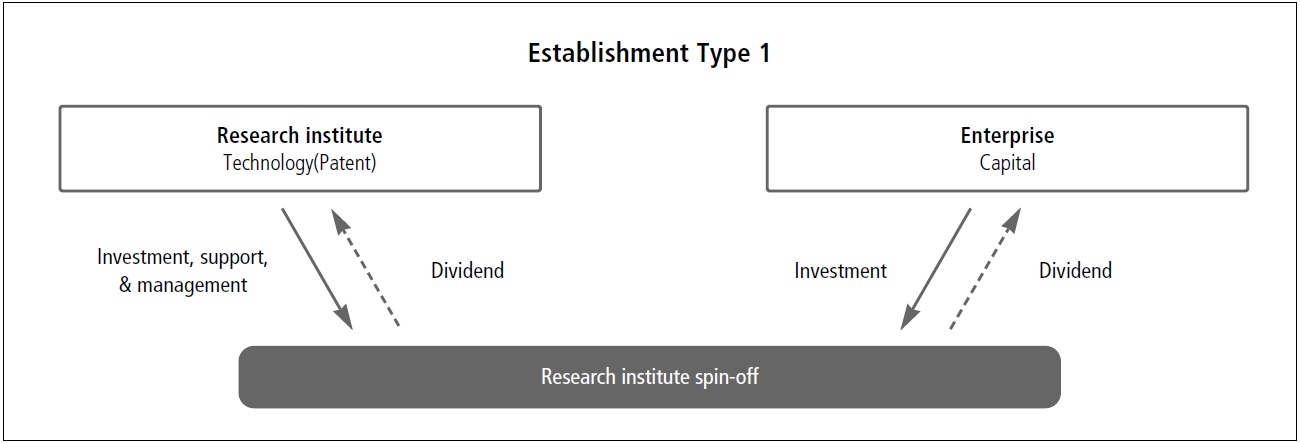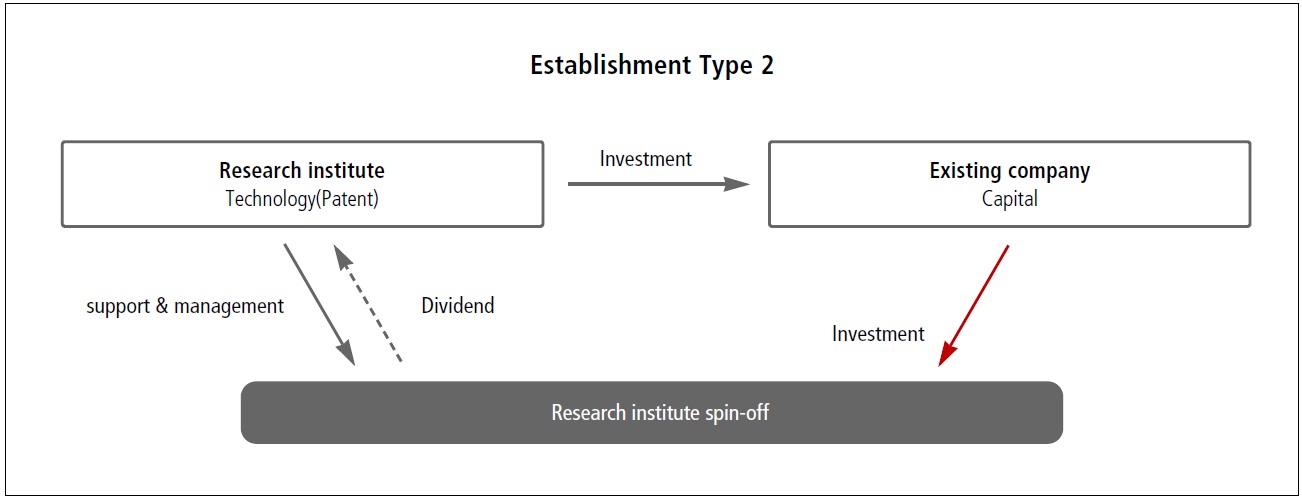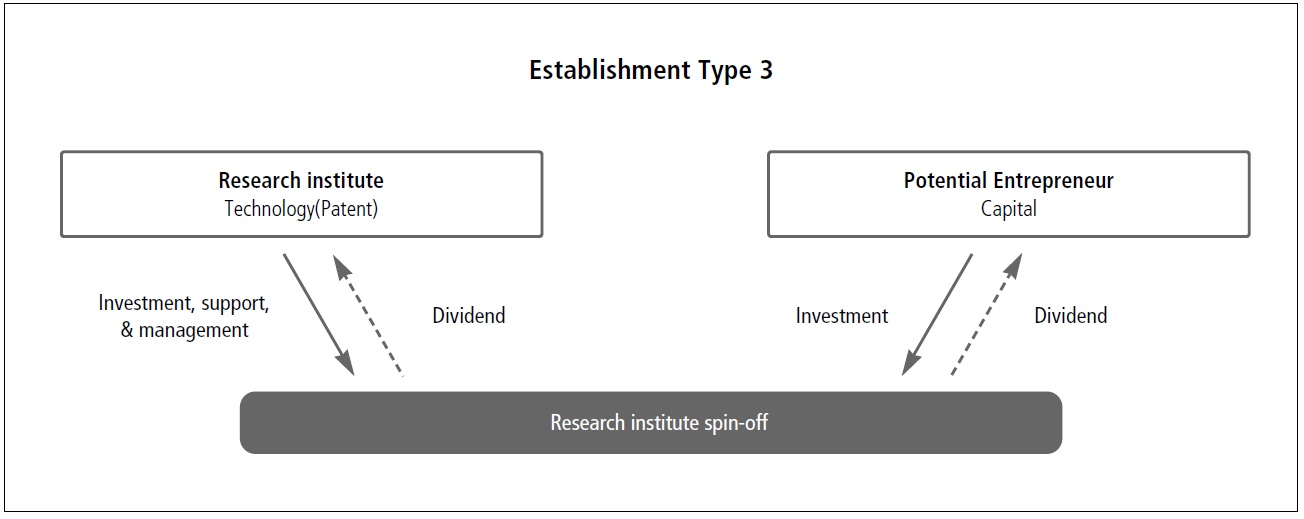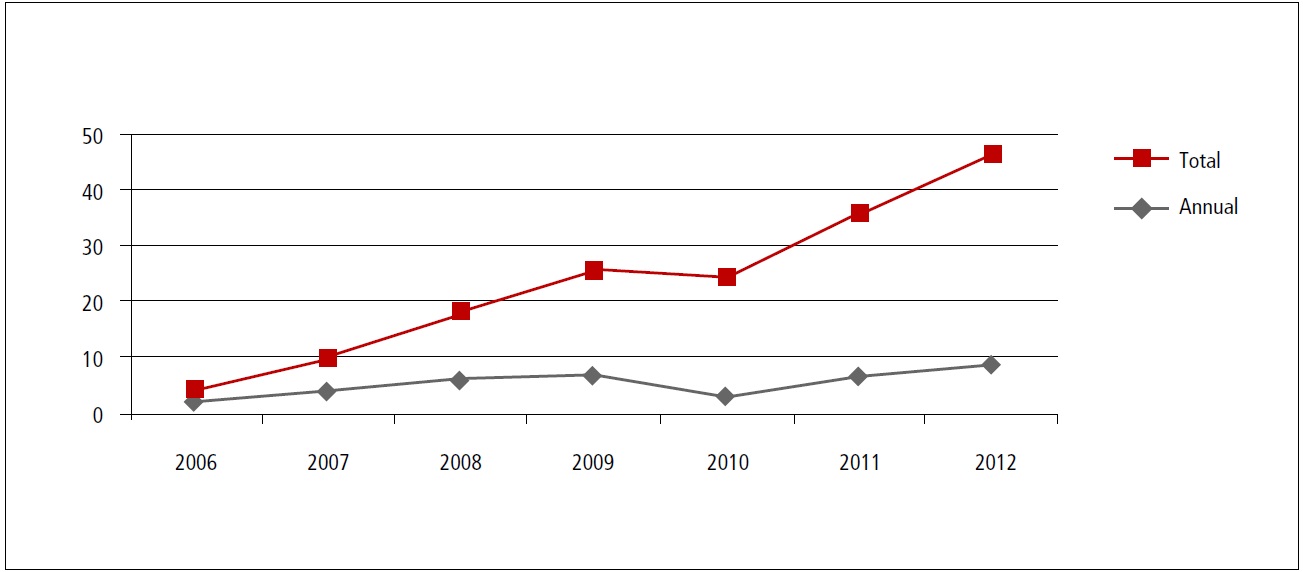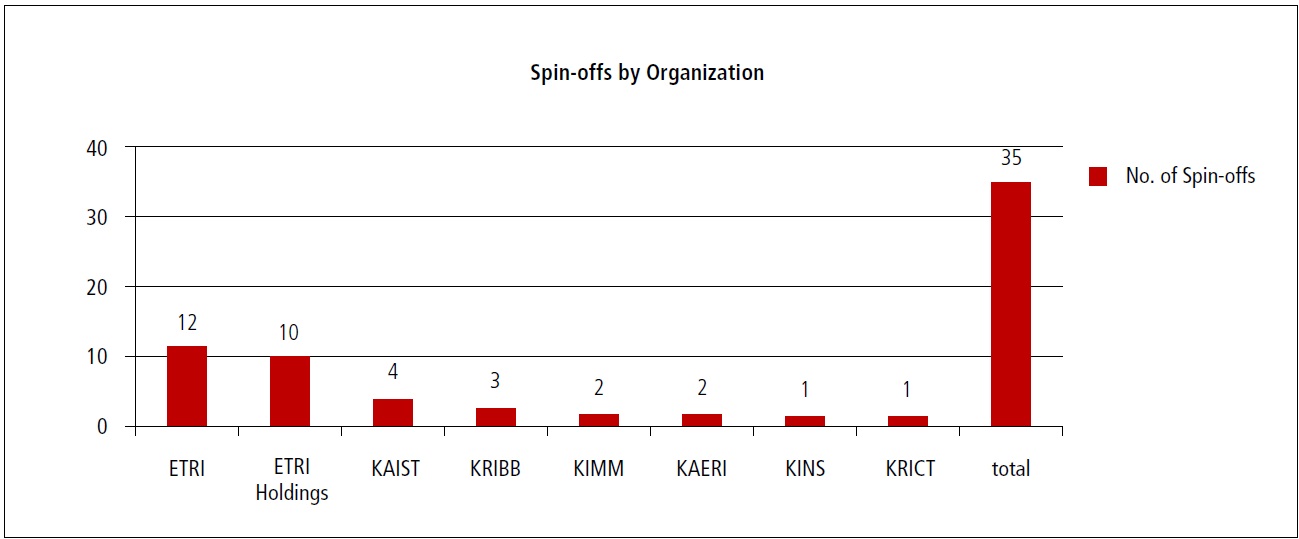



The growing challenge of competition in the world economy is pushing countries to reconsider concept of science and technology park (STP) as well as cluster. The world is moving towards an era of value network competition and advantage (Porter 1985;1990). Science and technology park can be considered as the simplest terms, property developments which aim to support research based commercial activity. Research institutes and universities are seen as repositories of science expertise, research, and advanced technologies. So the park can be understood as a mechanism by which research institutes can commercialize their accomplishments, or where companies are in order to access scientific knowledge and R&D results. The main concept of science and technology park is the idea that scientific knowledge leads in some linear progression to technological innovation (Quintas et al. 1992). Korean government has put significant level of investment in Daedeok Innopolis since 1973. Daedeok Innopolis has developed a lot in terms of the quantitative growth such as number of tenants and size of land. But the qualitative growth like level of commercialization of R&D results is to some extent low.
The focus for the development of Daedeok Innopolis has, therefore, been shifted gradually from hardware concepts for the park development to software concepts for more comprehensive innovation, which form today a key policy instrument for combining academic research, technical research and development (R&D) and market-driven solution provision (Launonen and Viitanen 2011).
Currently Daedeok Innopolis is the biggest science and technology park (STP) in Korea and has symbolized the development of Korea’s science and technology over the last 4 decades. Since 2005 it has tried to transform itself to an innovative cluster where R&D results from GRIs are commercialized in order to create the next growth engine for national economy based on the special law enacted for boosting capability of Daedeok Innopolis. As the key policy for facilitating commercialization in Daedeok Innopolis, the research institute spin-off was introduced in 2006 and the number is gradually increasing by help of tax benefits and diverse supporting programs from the Innopolis Foundation. Steffensen et al. (1999) insisted that an important factor in the success of a spin-off company is the degree of support that it receives from its parent organization. In this context, technology transfer is the application of information into use (Eto et al. 1995; Rogers 1995). Technology transfer ordinarily involves (1) a source of technology that possesses specialized technical skills, and (2) the transfer of technology to receptors who don’t possess these specialized skills and who cannot create the technology themselves (Williams and Gibson 1990). Technology licensing and spin-off companies are two important means of commercializing technology (Roberts and Malone 1996). A spin-off is a mechanism for technology transfer because the new company is usually formed in order to commercialize a technology which originated in (1) a government R&D laboratory, (2) a university, or (3) a private R&D organization. In case of Daedeok Innopolis, the research institute spin-offs can be established by technologies that come from government research institutes and universities.
This study is undertaken to review the interactive environment of the technology transfer in Daedeok Innopolis and study the unique system which enable Daedeok Innopolis to
[Table 1.] Resident Institutions by Areas in 2009

Resident Institutions by Areas in 2009
proceed technology transfer effectively and in particular, looks at the role which can be played by the Innopolis Foundation as a government agent of the policy aimed at facilitating commercialization of using technologies developed by GRIs.
Daedeok Innopolis is located at 32 legal administrative districts, dongs, of Yuseong-gu and Daedeok-gu, Daejeon Metropolitan City and the area is about 70.4 ㎢ based on the legal administrative districts, dongs, regulated in the enforcement ordinance. There are also 17 business incubation center in research institutions and universities, currently. Besides, industry-academia-research exchange center and techno business centers are located as park operation facility and Daedeok INNOPLOIS is also located there. The park is divided into dedicated general residential area, semi-residential area, commercial zone, green zone, education/research zone, business facility zone and industrial zone and restrictions are set on construction, business activities and development activities.
Following are the entities that form Daedeok Innoplis: 29 government-sponsored institutions (among them 18 GRIS); 14 government and public agencies, 7 public institutions, 5 education institutions, 17 venture incubation centers and about 1,100 firms (about 580 venture firms). The number of employees at Daedeok Innopolis about 45,526 in 2010.
Daedeok Innopolis is the area of the top research capacity in Korea focusing on government research institute. There are 29 government-sponsored institutions at the area, including 18 GRIs under both KRCI (Korea Research Council for industrial Science & Technology) and KRCF (Korea Research Council of Fundamental Science & Technology). R&D expenses of government-sponsored institutions at Daedeok Innopolis accounted for 31.9 % of total government R&D budget for 2009 and 10.4 % of gross expenditure in R&D (GERD). Total expenditure in R&D of Daedeok Innopolis was 17.2 % of GERD in 2009. The R&D expense of 29 government institutions was about KRW 3,933 billion in 2009; R&D expenditure (government budget) of 26 government research institutes was KRW 4,146.5 billion in 2009, that for public research institution was KRW 5,558 billion in 2009. Government R&D budget was KRW 12,344 billion in 2009, government burden of total R&D expenditure was 29 % in 2009 and percentage of GDP to total R&D expenditure was 3.57 % (KRW 37,929 billion in 2009). On the other hand, the number of research personnel was 20,522 persons, reaching half of total employment.
Daedeok Innopolis is the legally designated area and composed of 5 areas. The area includes Yuseong-gu and Daedeok-gu of Daejeon Metropolitan City and areas in the vicinity thereof, prescribed by Presidential Decree. Daedeok Innopolis has a size of 70.4 ㎢, about 2.5 times the size of Daedeok Science Town, which was built beginning in 1973 (Daedeok Science Town 27.8 ㎢, Daedeok Techno Valley 4.3 ㎢, Daedeok Industrial Complex 3.2 ㎢, Agency for Defense Development 3 ㎢, Green Belt 31.2 ㎢, and Hanwha 0.9 ㎢, etc.). In addition, the Innopolis Foundation manages the area under five main zones to unleash the potential of the innovation cluster: Zone I for Daedeok Science Town, Zone II for Daedeok Techno Valley, Zone III for Daedeok Industrial Complex, Zone IV for Northern Green Belt and Zone V for Agency for Defense Development. In Zone I, industry-academia-research institutes, government and public institutions, and support agencies are located. In Zone II and III, industries and corporate are located.
Daedeok Innopolis started as the national research and development hub in 1973 and has been transformed into the innovative cluster where research institutes, academia and industries work together to create synergy especially since the Innopolis special law was enacted in 2005. Based on the special law, the supporting and managing organization for the region, the Innopolis Foundation was established in 2005 with 4 strategies such as commercialization of R&D
[Table 2.] Designation of Daedeok Innopolis by the Law
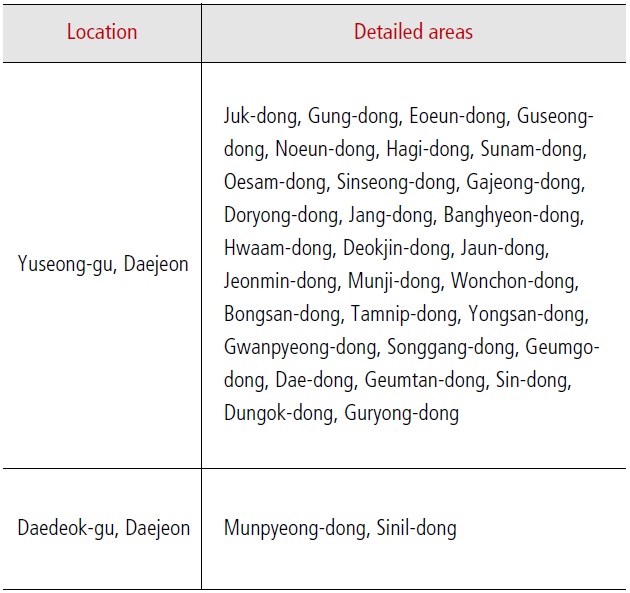
Designation of Daedeok Innopolis by the Law
results from GRIs, creating venture ecosystem for enterprises, disseminating success practices to nationwide as the national project, and building the global business environment to become a global standard cluster.
Structure and governance of Daedeok Innopolis are rather complicated. There are government-sponsored institutions in the park as the innovation entities, as well as government/ public institutions, public corporations, non-profit institutions and enterprises. Institutions except enterprises are under direct influence of ministries of government and they play different roles and missions respectively. Core government branches that form the upper-level policy governance of Daedeok Innopolis are the Ministry of Knowledge Economy (MKE) and the Ministry of Education, Science and Technology (MEST). Most government research institutes belong to these two Ministries. On the other hand, MKE exercises the approval rights on the enterprises who desire to move into the District.
Besides, the Ministry of Land, Transport and Maritime Affairs (MLTM) have an influence related to park development, and Daejeon Metropolitan City Government exercises influences related to various provincial permissions and approvals. Most government research institutes belong to Korea Research Council for industrial Science & Technology (ISTK) and Korea Research Council of Fundamental Science & Technology (KRCF). ISTK is under direct influence of MKE and KRCF under direct influence of MEST. Other government research institutes are under direct control of each government agencies.
Since government research institutes play critical roles in carrying out the government policy on science and technology, government research institutes under ISTK are given with roles and missions according to the technology policy of MKE. On the other hands, government research institutes under KRCF are affected by the science and technology policy of MEST.
It means that government research institutes take charge of ‘knowledge production’ in the innovation cycle among resident enterprises or institutions in Daedeok R&D Special District and that they not only take charge of the upstream of regional cluster but also play critical roles in national innovation system.
Government/public institutions, public corporations and non-profit institutions exert direct/indirect influence on the R&D activities but do not play critical roles in Daedeok R&D
Special District, except some government/public institutions, public corporations and non-profit institutions.
The Innopolis Foundation is under the direct control of MKE as the entity of park operation and management and is administratively related to MLTM and Daejeon Metropolitan city. At present, the most important role of the Foundation is the operation and management of the park but is limited in terms of the roles of developing the park as an innovation cluster. The Foundation lacks to some degree the capability to push forward the program to facilitate the innovation activities with active participation of innovation entities since its history is rather short and is in the process of raising the capacity as the support organization.
From the viewpoint of private enterprises, as one of innovation entities, however, they can have the greater access to technological opportunities as nearby government research institutes and universities have actively conducted R&D, which means superior environment for innovation than other places.
The role and mission of the Innopolis Foundation is to facilitate commercialization of accomplishments of national science and technology in Innopolis through training of science and technology talents and research/development of state-of-the-art technology. It also plays a role as the strategic foothold of regional economy development, contributing to balanced development of the country. Other roles and missions include securing of adequacy of land use through effective use and management of land, and pursuing of balanced development of research park through systematic arrangement of education, research facility, residential and commercial, culture and welfare facilities. The Innopolis Foundation provides reasonable guide and management of resident institutions to comply with the purport of creation of research park and goal of their movement into the park. It is to preserve the green and raw land in the original form as much as possible. There are now 3 Innopolises including Daegu and Gwangju as well as Daedeok in Korea.
2.2 Supporting program of the Innopolis Foundation
The Innopolis Foundation since 2005 has grown Daedeok Innopolis to become the home to over 1,100 SMEs through its major programs as below after Daedeok research park was transformed into a innovative cluster with newly developed industrial area, Zone 2. With these programs, the Innopolis Foundation directs substantial effort to transform research results at Daedeok Innopolis into companies and products generating revenue. The supporting programs consist of 4 main sub-programs such as venture incubation project, three-up program, special clustering project and total design project. And these supporting programs are used for activities which promote research institute spin-off mechanism.
(1) Venture Incubation Project
It has solved difficulties and cultivated the business incubation and star business through systematic business support of small and middle venture enterprises in Daedeok Innopolis.
This technology business creation and management services provide customized consulting service and solutions about difficulties that the enterprises might encounter with regard to the commercialization of research performance.
(2) Three-Up Program
As an life-time business supporting program for entrepreneurs, the Innopolis Foundation provides three-up program which consists of 3 sub-programs like start-up, high-up and lift-up. Start-up is to educate prep entrepreneurs starting high-tech based businesses to grow the entrepreneurship and make basic business plan. And high-up supports the early production through continuous business plan monitoring. Lift-up supports implementation of the business expansion strategy with active commercialization of excellent business items identified through special technology joint development projects.
(3) Special Clustering Project
Special clustering project has been facilitated in connection with the enterprises with big demands based on the technologies that public research institutes have, facilitating early commercialization of performance of research and entrance into the market. And it has been strategic positioning of Daedeok Innopolis as the center of new business creation through hub-spoke type business promotion in connection with other strategic business areas.
(4) Total Design Project
This project is to maximize the success of advanced technology commercialization and to facilitate the success of enterprises through operation of comprehensive support system from planning of new business model, design development, and marketing support. Business model design was developed, merging the excellent technology of research institutes or enterprises in the Special District. Marketing support was given in connection with prominent enterprises at home and abroad as well as production of prototype including technical design for the developed model. The project has facilitated the commercialization and transfer public technology by supporting the technology transfer and marketing for the technology jointly developed by private commercialization enterprises and public TLO (Technology Licensing Office) as the excellent technology identification project.
As the patent packaging-based technology marketing project, it has contributed to the activation of technology transfer and reduction of technology transaction cost so as to purchase patents required for demand technology at bulk. And as a strategic business commercialization project, it has supported the solution required for business advancement or new business model utilizing the public technology.
3. RESEARCH INSTITUTE SPIN-OFFS
Spin-offs from either research institutes or universities are not a new idea for technology transfer. The survival rate of the spin-offs, 3-year after starting their businesses, appears to be 75 % (Chong 2012). It is much higher than that of normal start-up survival rate after 3 years, 46 %. Spin-offs are a means of technology transfer from a parent organization that represent a mechanism for creating jobs and new wealth (Steffensen, et al 1999). And Steffensen (1999) suggested that there are two types of spin-offs: (1) planned, when the new venture results from an organized effort by the parent organization, and (2) spontaneously occurring, when the company is established by an entrepreneur who identifies a market opportunity and who founds the spin-off with little encouragement (and perhaps with discouragement). However, performances for setting up spin-offs vary significantly across organizations. Explaining cross-organization variation in start-up activity is explained for four reasons such as understanding source of knowledge spillovers, proximity to economic development and agglomeration economies, Supports from TLO, inventor and CEO of organization, and norms and policies of organization (Gregorio and Shane 2003).
Based on Special Act on fostering Daedeok Innopolis, Daedeok Innopolis is granted to have a special policy to create spin-offs from government research institutes in Daedeok Innoplis. The special policy allows spin-offs from GRIs to have tax benefits after meeting several conditions like ownership and company location. The “research Institute Spin-off” was prescribed legally, defines as in the table below.
“Research institute spin-off ” refers to a company established in Daedeok Innopolis with investment in kind of more than 20 % by appropriate entities set forth in the law, on its own, or jointly, for the purpose of starting a business with the technology a government research institutes developed and hold. (article 9, 3, enforcement act, article 13 in the special law of Daedeok Innopolis)
The movement of creating the policy of research institutes spin-offs was originated from a criticism that the achievement from R&D of government research institutes does not lead to a production and business in a real industry field while the R&D investment by administration is consistently increasing since 1990. The underlying view is indicating that the primary reason of low rate of successful technology commercialization based on the public R&D results can be found in the inefficiency of business mechanism in the R&D institutes, e.g. unified commercialization approach simply focusing on a license. In improving such environment, it is being emphasized that the appropriate support is required for the strategy of optimizing the success rate of business by activating a wide range of technology commercialization methods, e.g. by technology capital investment, research joint company, professor or researcher’s start-up etc considering the characteristics of developed technologies and qualification of business entity collectively.
From a critical viewpoint in this regard, as the method of promoting business at to achievements of R&D (research and development) that government research institutes hold, this supporting policy of research institute spin-off has been reviewed as the alternative of establishing a company and joining into the operation by investing a technology in addition to the existing technical license and researcher’s startup. Accordingly this system has been enacted and is introduced to the Daedeok Innopolis Special Act by reviewing the feasibility study of research institute spin-offs.
From the standpoint of government research institutes, the introduction of supporting policy of research institute spin-off is to re-establish the function in the way of being centered on the target, commercialization of R&D results and promotion of utilization as well as the role of the conventional focus on the R&D. In addition, it is expected to encourage innovation network both private companies as the user and government research institutes as a technology provider work together by combining an excellent government R&D results, private capital and management knowhow.
The entity which is entitled to establish a research institute spin-offs in accordance with the law of Daedeok Innopolis is “government research institute, educational & industrial cooperation tech-holding company, and new-tech start-up supporting company.”
Research institutes spin-offs get two main benefits. The most biggest and important benefit is the tax benefits as below.
National taxes: income tax and corporate tax exemptions (100 % exemption for three years and 50 % reduction for the next two years)
Local taxes: acquisition and property tax exemptions (100 % exemption for seven years and 50 % reduction for the next three years)
The other is the full process business support program which helps spin-offs to prepare business action plan and to commercialize the technology from a research institute with supporting matching fund. This program supposedly provides life time support to spin-offs for the whole business process from stage 1 to stage 5 in the <Fig.2> below.
During from stage 1 to 5, the program helps spin-offs to improve and select among their business items by introducing business consultant and technology professionals for commercialization. So stage 1 and 2 are elements of opportunity evaluation structured around series of questions and analytical tools that guide technology commercialization neophytes to ask fundamental questions about a variety of topics covering technology, legal, marketing, organization, manufacturing, financial, industry and competitive issues (Barr, Baker, Markham and Kingon 2009). These stages can be functional and strategic assessment periods. While spinoffs go through all stages, they meet the missing link which
is the transition from an existing or emerging technology to the creation of a compelling new market-driven business. And this gap is referred to as the “valley of death” in commercialization of technology (Auerswald and Branscomb 2003; Markham 2002; Marczewski 1997). The program is designed to fills some part of the gap between business plan and production for spin-offs.
The establishment for research institutes spin-offs can be categorized generally onto three types. The first type is that both a research institute and an existing company make a joint venture through co-investment with technology and cash as the <Fig. 3>.
The second type is that a research institute invests the technology into a existing company, and the company is converted into a research institute spin-off as the <Fig. 4>.
The third type is that both a research institute and a potential entrepreneur set up a new venture through coinvestment with technology and cash in collaboration with each other as the <Fig. 5>.
The procedure of establishment of research institute spinoff shall be either that a public research institute discovers a corresponding technology and exploring/evaluating/selecting a partner company for joint venture, or that other company proceeds by proposing to establish a research institute spin-off to the government research institute. In case of proceeding an establishment of research institute spin-off by a public research institute, it includes following procedures 1)
search and discovery of a corresponding technology to be established, 2) study of feasibility for establishment, 3) discovery and selection of partner company for joint venture, 4) agreement of establishment/technology value.
Since the policy was introduced in Daedeok Innopolis in 2006, the average annual number of registered spin-offs is 5.4. As of the end of 2012, total 35 spin-offs have been established in Daedeok Innopolis. Even though the number and rate of increase is somewhat small, the number has been increasing slowly. The number of company by industry is that companies in ICT are over 50 % and the second biggest industry is 16 % with bio and life science. This shows the same proportion of industry as the breakdown of the whole industry in Daedeok Innopolis.
While there are 29 government research institutes and 5 universities, the numbers of the spin-offs by each organization in Daedeok Innopolis are concentrated in several institutes. The most dominant research institute is Electronic and Telecommunication Research Institute, ETRI and the second one is ETRI holdings. But considering ETRI holdings is the subsidiary of ETRI, ETRI and ETRI holdings can be regarded as the one organization. So 22 of total 32 spin-offs came from ETRI, which stands for 62.8 %. The second largest holder is KAIST (Korea Advanced Institute of Science and Technology) with 4, the third KRIBB (Korea Research Institute of Bioscience and Biotechnology) with 3 and others, while most of GRIs and universities has none. Yang and Choi (2010) suggested lack of the in-house educational program for increasing the business capabilities of potential entrepreneurs in research institutes as well as weak institutional framework as the main reasons for not generating more research institute spin-offs.
This paper analyzed reasons why some research institutes generate more start-ups than others (Greorio and Shane 2003). Considering the study of Greorio and Shane, this paper suggests three reasons about why there are many differences among GRIs in generating research institute spinoffs. The first reason is the research area. Research institutes that conduct applied technology research could be more likely to generate commercially-oriented discoveries and know-hows. And those discoveries and know-hows can be easily used for establishing Spin-offs by researchers or enterprises. The Second is pro-business policies in organizations. Good incentives and supporting programs for entrepreneurial activity in organizations could encourage more researchers to consider starting their own businesses, and researchers can test the initial implementation of business ideas while taking leaves of absence from their main jobs. The third is research capabilities. Research capabilities among GRIs can be assessed by number of patents and number of joint projects between GRI and private company. More patents and joint projects can expose researchers to business environment. So researchers can learn entrepreneurship with working with private sectors.
The aim of this paper was to review the history of Daedeok Innopolis and activities of the Innopolis Foundation for technology transfer. Since Daedeok Innopolis was reborn in 2005 to be the innovative cluster from the research park, the Innopolis Foundation as the main facilitator in Daedeok Innopolis has played a pivotal role in creating start-ups through diverse technology transfer supporting programs. The most unique mechanism for generating start-ups is the research institute spin-off among other incubation programs. Research institute spin-offs reflects diverse positive economic effects such as utilization of outcomes of GRIs, job creation, regional development, etc so that the Innopolis Foundation should keep putting more efforts on this than other supporting programs.
Finally, whether the efforts would succeed would depend on how successful the Innopolis Foundation interacts with stakeholders like central and local governments, research institutes, universities and commercialization services entities with reflecting newly suggested needs rapidly.




